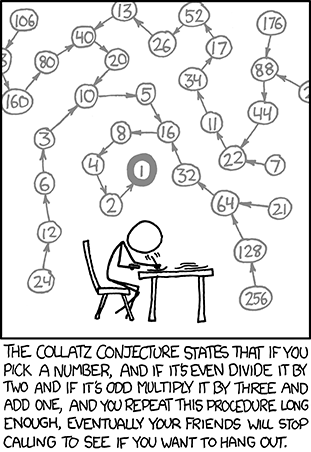The Most Dangerous Problem
Whereas we are unsure of the definitive, exact origin of the problem, it has become traditionally and eponymously associated with Lothar Collatz (1910-1990), a German mathematician known for his work in numerical analysis, who posed this deceptively simple looking problem in 1937. 'Such simplicity, however,' in the words of Alex Bellos, 'stands in striking contrast to the difficulty of proving the conjecture itself.'
Indeed, proving Collatz's conjecture is widely considered to be completely out of our current reach, and provoked the prolific mathematician Paul Erdős to state that 'mathematics is not yet ready for such problems.' It has been described as 'uncrackable,' called 'the simplest impossible problem,' and monikored as 'the most dangerous problem in mathematics' because ― as mathematician Jeffrey Lagarias, the World's leading expert on the Collatz Conjecture states ― 'people become obsessed with it, and it really is impossible.' Mathematician Alex Kontorovich goes further and says that if 'someone actually admits in public that they're working on it, then there's something wrong with them!' (The cartoon from the wonderful xckd.com below will give you the general gist.)
Kontorovich even describes how some people have suggested that during the cold war people thought 'it was something invented by the Soviets to slow down U.S. science... because everybody [would be] sitting there twiddling their thumbs on this trivial thing that you can tell school children.' The problem has also been called Kakutani's problem, after the mathematician Shizuo Kakutani, who relayed the 'joke' that 'this problem was part of a conspiracy to slow down mathematical research in the U.S.'
The Collatz Conjecture
In short, Collatz's conjecture is that the following algorithm...
- Choose any positive integer you want.
- If the number you chose is even, divide it in half.
- If it is odd, multiply it by 3 then add 1 (hence the \(3x + 1\)).
- Repeat this process.
...will eventually produce the number 1, regardless of which positive integer is chosen initially.
Most mathematicians believe this to be true. Indeed, by 2008 we had tested Collatz's algorithm for all numbers up to \(19 \times {2^{58}} = 5,476,377,146,882,523,136\) and found that they always, eventually reached 1. By 2018, the upper limit of numbers we had tested and shown to always reach 1 was \({2^{100000}-1}\), which has over 30,000 digits and so too large to write here, and which needed to apply the \(3x + 1\) computation 481,603 times and the \( \div 2\) computation 863,323 times. As of 2024, David Bařina's computer systems checked around 220 billion numbers per second (i.e. 1.361 light mm per number) to push this upper limit to \({1.5\times 2^{70}}\), or 1,770,887,431,076,116,955,136. But none of this, of course, proves that reaching 1 is always the case. And as yet, no-one has a clue how to prove it.
Examples
If we start say with 19...
- 19 is odd, so we multiply it by three to get 57, then add one to get 58
- 58 is even, so we halve it to get 29
- 29 is odd, so we multiply it by three to get 87, then add one to get 88
- 88 is even, so we halve it to get 44
- 44 is even, so we halve it to get 22
- 22 is even, so we halve it to get 11
- 11 is odd, so we multiply it by three to get 33, then add one to get 34
- 34 is even, so we halve it to get 17
- 17 is odd, so we multiply it by three to get 51, then add one to get 52
- 52 is even, so we halve it to get 26
- 26 is even, so we halve it to get 13
- 13 is odd, so we multiply it by three to get 39, then add one to get 40
- 40 is even, so we halve it to get 20
- 20 is even, so we halve it to get 10
- 10 is even, so we halve it to get 5
- 5 is odd, so we multiply it by three to get 15, then add one to get 16
- 16 is even, so we halve it to get 8
- 8 is even, so we halve it to get 4
- 4 is even, so we halve it to get 2
- 2 is even, so we halve it to get 1
- 1 is odd, so we multiply it by three to get 3, then add one to get 4
- 4 is even, so we halve it to get 2
- 2 is even, so we halve it to get 1




No comments:
Post a Comment